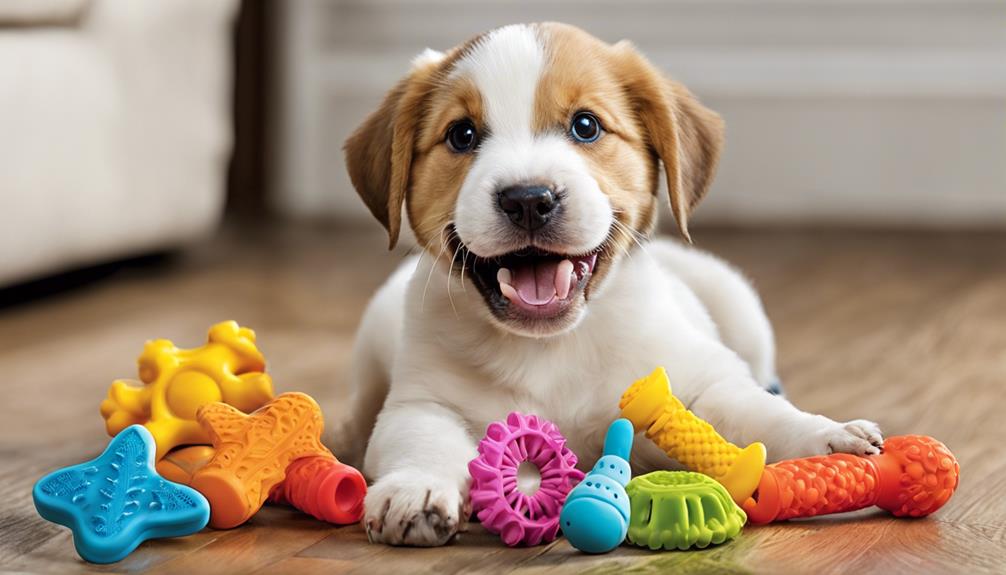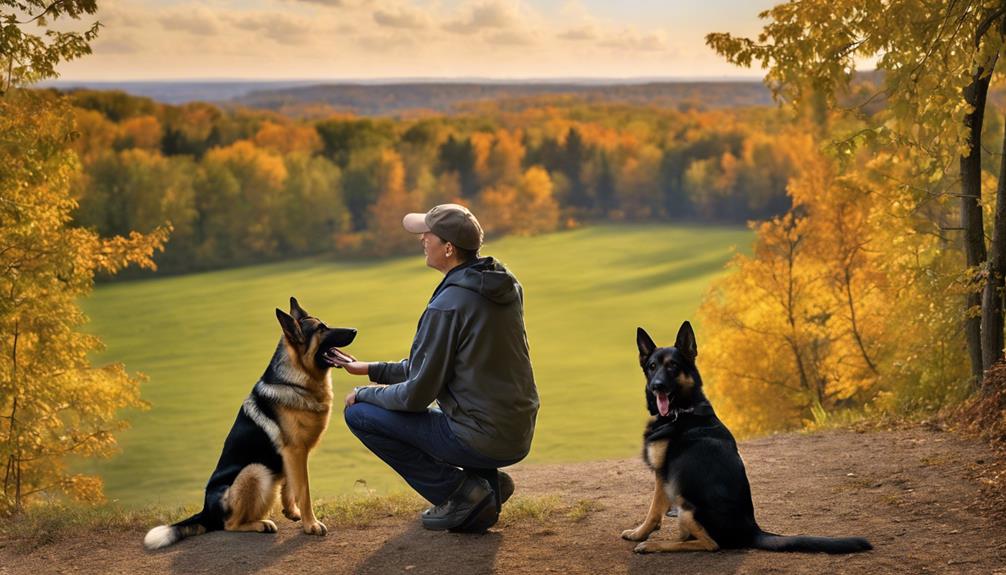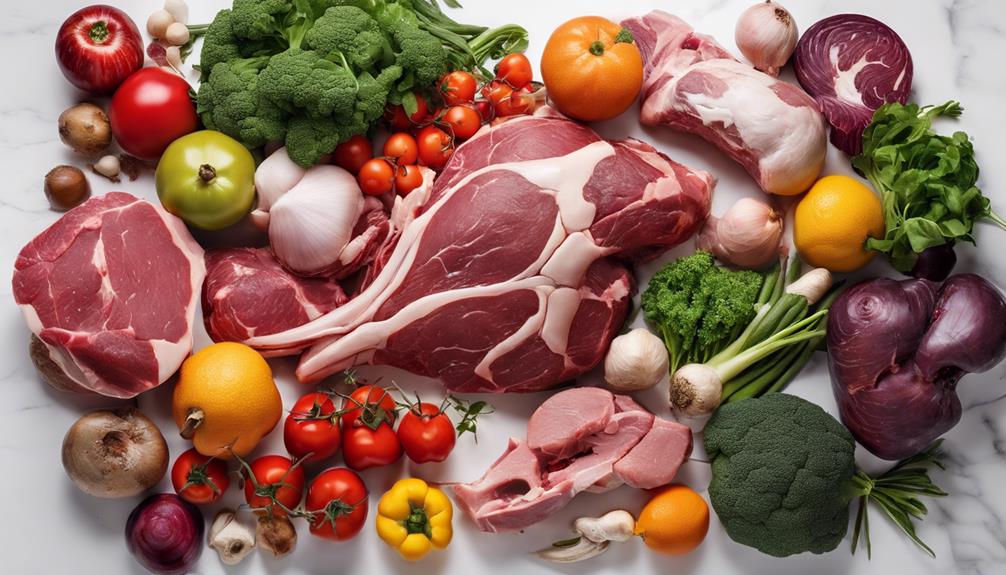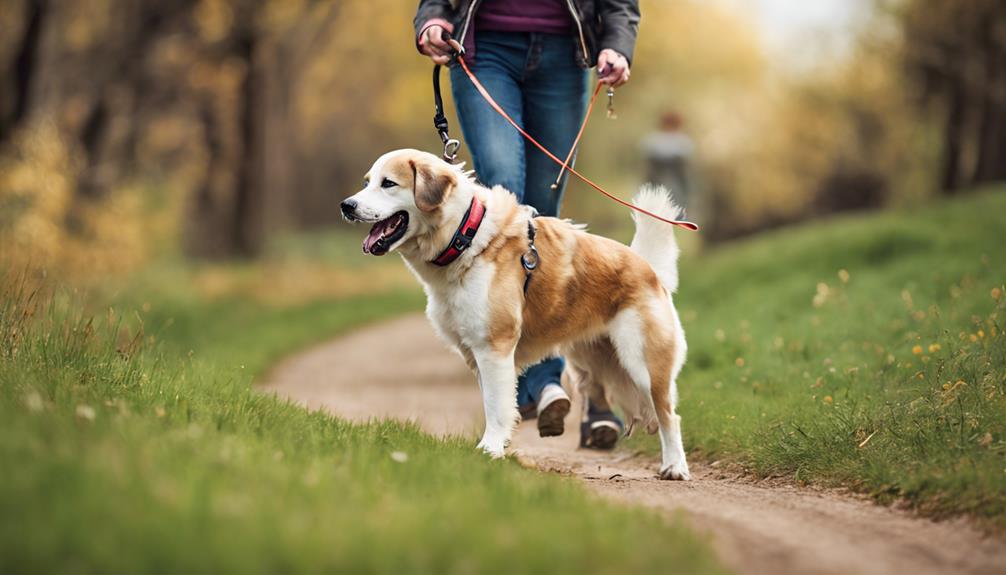When teaching your puppy about potty training using a crate, it’s important to establish a positive and comfortable area. Consistency is crucial, so follow a routine that matches your puppy’s bathroom needs. Remember that young puppies have small bladders, so they will need to go outside often. Begin by introducing the crate slowly, using treats and praise to create positive associations. Make the space inviting with bedding and toys, and gradually increase the amount of time your puppy spends alone in the crate. Incorporate interactive games and stimulating toys to make the training enjoyable. Proper crate training establishes the groundwork for a healthy relationship.
Key Takeaways
- Tailor potty breaks to puppy's age for bladder control.
- Avoid prolonged crating to prevent accidents and discomfort.
- Customize schedule for routine needs of different age groups.
- Consistent feeding, potty breaks, and nap times are vital.
- Structured routine crucial for successful crate training at various puppy ages.
Importance of Crate Training
Crate training is crucial to teaching your puppy where and when to go potty, establishing the foundation for good behavior in the future. When introducing your puppy to crate training, make sure the crate is a positive and comfortable space. Start by gradually acclimating your puppy to the crate, using positive reinforcement like treats and praise. Establish a consistent schedule for crate training, including regular potty breaks to assist with house training. Remember, puppies have small bladders and need frequent bathroom trips.
Using the crate for potty training helps your puppy understand when and where it's appropriate to relieve themselves. It also prevents them from having accidents around the house, promoting cleanliness and discipline. By incorporating crate training into your puppy's routine, you're instilling good habits early on and setting them up for success in the future. Crate training is a valuable tool recommended by experts for housebreaking and preventing destructive behaviors.
Benefits of Crate Training Schedule

To fully appreciate the benefits of adhering to a structured crate training schedule for your puppy's potty training success, it's essential to understand how consistency and routine play a pivotal role in fostering positive behavior. A well-planned crate training schedule provides your puppy with a structured routine, including specific potty breaks, which helps in preventing accidents and promoting successful potty training.
By following a consistent schedule, you assist your puppy in establishing good habits early on, ensuring they learn to control their bladder effectively. Predictability is key in reducing anxiety and uncertainty for your puppy, creating a sense of security. Additionally, the consistency in implementing a crate training schedule not only aids in bladder control but also strengthens the bond between you and your puppy.
Through this structured approach, you aren't only setting your puppy up for potty training success but also establishing a foundation for a lifelong positive relationship.
Proper Crate Introduction Steps
When introducing the crate to your puppy, create a welcoming environment by placing comfortable bedding and some familiar toys inside.
Encourage positive associations by rewarding your puppy with treats for exploring the crate voluntarily.
Gradually increase alone time in the crate to help your puppy adjust to being separated from you in a calm and secure manner.
Crate Setup Essentials
Upon bringing your new puppy home, it's crucial to establish a positive association with the crate right from the start. Here are some crate setup essentials to guarantee a smooth introduction:
- Interactive Games: Initiate the crate training process with interactive games and the shaping method to make it enjoyable for your puppy.
- Toys and Treats: Utilize toys and treats inside the crate to create a positive environment and motivate your puppy to enter willingly.
- Rubber Toy with Food: Consider using a rubber toy filled with food to keep your puppy engaged and occupied while in the crate.
These steps will assist in making the crate a comfortable and inviting space for your puppy, assisting in the crate training process and overall potty training success.
Positive Association Building
Establishing a positive association with the crate from the beginning is essential for successful puppy potty crate training. Use toys and treats to create a safe and enjoyable environment when introducing the crate. Encourage your puppy to explore the crate by placing enticing toys or treats inside. This helps build a strong bond between your puppy and the crate.
Consider stuffing a rubber toy with food to make crate time engaging and rewarding. If you find crate training challenging, don't hesitate to seek professional guidance. A coach can provide effective techniques tailored to your puppy's needs, ensuring a positive crate training experience that fosters bonding between you and your furry companion.
Gradual Alone Time
To properly introduce your puppy to the crate, begin with short periods of alone time to help build their confidence in this new space. Here are three essential steps to guarantee a successful crate training experience:
- Start Small: Begin by leaving your puppy alone in the crate for short intervals, gradually increasing the time as they become more comfortable.
- Use Positive Reinforcement: Reward your puppy with treats and toys when they enter the crate willingly, helping them associate the crate with positive experiences.
- Seek Professional Guidance: If your puppy shows distress signs during crate introduction, consult a professional trainer for expert advice on how to acclimate them to the crate effectively.
Positive Reinforcement Techniques

When it comes to positive reinforcement techniques in crate training, using treats or clicker training can be highly effective. Treat rewards serve as motivation for your puppy to learn and repeat desired behaviors consistently.
Incorporating clicker training benefits can help create a strong association between good behavior and receiving rewards.
Clicker Training Benefits
Utilizing clicker training in puppy potty crate training presents numerous benefits through its effective positive reinforcement techniques. Here are three key advantages of incorporating clicker training into your puppy's routine:
- Mark Desired Behaviors: Clicker training allows you to precisely mark the exact moment your puppy exhibits the desired behavior, making it easier for them to understand what they're being rewarded for.
- Efficient Learning: The precise timing of the clicker helps streamline the learning process, enabling your puppy to associate actions with rewards more efficiently.
- Teach New Commands and Tricks: Clicker training can be a powerful tool for teaching your puppy new commands, tricks, and behaviors effectively and quickly. The distinct sound of the clicker serves as a clear signal for your puppy to grasp what behavior is being reinforced.
Treat Rewards Effectiveness
Incorporating treat rewards effectively enhances positive behaviors during crate training sessions with your puppy. When you use high-value treats, such as small pieces of chicken or cheese, you can increase your pup's motivation and engagement during training.
Over time, as your puppy becomes more familiar with commands, you can gradually shift to verbal praise and physical affection to solidify obedience. Shifting to verbal praise and physical affection as rewards can further encourage obedience and strengthen the bond between you and your pup.
Positive reinforcement through treats not only aids in crate training but also fosters a trusting relationship with your puppy, making the training process more enjoyable and effective for both of you.
Role of Crate in Potty Training

Using a crate during potty training is a key strategy to facilitate a clean and efficient learning process for your puppy. Crates serve as a valuable tool in the housebreaking journey, aiding in preventing accidents and teaching your puppy proper potty habits. Here are three essential roles a crate plays in potty training:
- Vital Space: A crate provides a secure environment for your puppy when you can't directly supervise them. By confining them to the crate when unsupervised, you can prevent accidents in the house, as dogs naturally avoid soiling their sleeping area.
- Monitoring Aid: Constant supervision is important during potty training, and a crate helps manage this effectively. When you're unable to keep a close eye on your puppy, the crate ensures they're in a controlled space, reducing the likelihood of accidents.
- Behavioral Training: Crate training can be a temporary or permanent solution based on your dog's behavior and needs. It helps your puppy learn bladder control and establishes a routine for potty breaks, setting them up for long-term success.
Tips for Successful Crate Training

To enhance your puppy's crate training success, gradually increase the time spent in the crate to build comfort and familiarity. Begin with short intervals and slowly extend the duration as your puppy becomes more accustomed to the space.
Utilize treats and toys as important reinforcement when introducing your puppy to the crate, creating a positive association with this training tool. It's essential to follow recommended guidelines for crate duration based on your puppy's age to prevent accidents and guarantee effective training.
Monitor your puppy's comfort level in the crate closely to make sure a positive training experience without causing undue stress. Evaluate your puppy's response and behavior to determine the long-term use of the crate; some dogs may benefit from continued crate training, while others may require different methods.
Crate Training Beyond Potty Training

Beyond potty training, crate training serves as a foundational method for creating a secure and comfortable space for your puppy. Here are three key benefits of crate training beyond just potty training:
- Establishing a Secure Den-Like Environment: Crate training helps your puppy feel safe and secure, mimicking the den-like spaces their wild ancestors sought for protection. This sense of security can reduce stress and anxiety, promoting overall well-being.
- Developing Good Behavior Habits: The structured environment of a crate encourages puppies to learn good behavior habits, such as not chewing on furniture or belongings. It provides a designated space where they can rest, relax, and learn to self-soothe.
- Managing Separation Anxiety: Crate training can be instrumental in managing separation anxiety by offering a familiar and calming retreat for your puppy when you're not around. This can prevent destructive behaviors and help them adapt to routines more easily.
Versatility of Crate in Different Situations

Utilizing the flexibility of a crate proves crucial in maneuvering through various situations with your puppy. A crate serves as a versatile tool that offers safety and security, providing a comforting space for your furry friend. Whether it's a vet visit, grooming appointment, or travel, the crate becomes a familiar environment where your puppy feels secure and comfortable. Additionally, the crate helps manage your dog's behavior in new environments, guaranteeing a sense of home even when away from the familiar surroundings. By incorporating the crate into different situations, you create a stable and consistent space for your puppy, promoting a sense of calmness and security. Check out the table below to see how a crate can be beneficial in various scenarios:
| Situation | Benefits of Crate |
|---|---|
| Vet Visits | Provides a secure space for your puppy |
| Grooming Appointments | Ensures safety and comfort during grooming |
| Travel | Gives your dog a familiar environment |
| New Environments | Helps manage behavior effectively |
| Home Environment | Acts as a comforting and secure space |
Age Considerations in Crate Training Schedule
When considering the appropriate age for crate training your puppy, it's essential to understand their specific needs and developmental stages.
- Tailoring Potty Breaks: Younger dogs require more frequent potty breaks based on their age. Adjust the frequency of breaks as your puppy grows to accommodate their developing bladder control.
- Avoiding Extended Crating: Puppies shouldn't be crated for extended periods, with adjustments made according to age. Keep crating time shorter for younger puppies to prevent accidents and discomfort.
- Customizing the Schedule: Tailor the schedule to the specific routine needs of different age groups. Consistent feeding, potty breaks, and nap times are vital considerations for all age groups. Following a structured routine is essential for successful crate training at different puppy ages.
Understanding these age considerations in your crate training schedule will help set your puppy up for success in their potty training journey. By customizing the routine based on their age and needs, you can create a structured and effective training regimen that supports your puppy's development.
Frequently Asked Questions
How Long Do You Have to Keep a Puppy in a Crate for Potty Training?
To train your puppy effectively, keep them in a crate for the duration of their age in months plus one. Adjust this time based on signals and age to prevent accidents. Initially, ignore whining to reinforce the training schedule.
What Is the Best Schedule to Potty Train a Puppy?
To potty train a puppy successfully, establish a consistent routine for bathroom breaks by monitoring cues, creating a log, and implementing a fixed feeding schedule. This structured approach helps reinforce training consistency and aids in establishing a potty training routine.
What Is the 10 Minute Rule for Puppies?
To understand the 10 Minute Rule for puppies: it indicates that for every month of age, a puppy can typically hold their bladder for about one hour. Following this rule helps determine when they need potty breaks.
How Many Hours a Day Should My Puppy Be in His Crate?
You should limit your puppy's crate time to his age in months plus one hour. Adjust based on signals for potty breaks and comfort. Provide regular breaks for elimination and stretching. Ignore initial whining to foster calmness in the crate.
Can I Use the Ultimate Puppy Crate Training Schedule for Different Ages on the Same Puppy?
Yes, you can use the ultimate puppy crate training schedule for different ages on the same puppy. It’s important to adjust the schedule based on their age and level of training. With consistency and patience, the ultimate puppy crate training schedule can be effective for all stages of puppy development.
Conclusion
To sum up, remember that crate training is the ultimate tool for successful potty training with your puppy. It provides structure and guidance, helping your furry friend learn good habits. So, stick to the schedule, be patient, and use positive reinforcement.
But remember, even the best training plan may have some surprises along the way. So, be prepared for some unexpected accidents and setbacks, but stay consistent and your puppy will eventually get the hang of it.










